Abstract
We reviewed 37 consecutive, hemodynamically stable patients (16 adults, 21 children) who had splenic injuries diagnosed by computed tomography (CT) scan to compare the CT evaluation with operative assessment of injury and eventual treatment. Computed tomographic scans and operative findings were graded by a splenic injury scoring system. Two patients were classified as having grade 1, 21 as grade 2, 11 as grade 3, and 3 as grade 4 splenic injuries. Computed tomography underestimated the degree of injury in 9 of 17 (53%) operated patients (mean CT score, 2.6; mean operative score, 3.3; p less than 0.01). Six of sixteen adults and 19 of 21 children were intentionally treated by observation. There were 5 treatments failures (20%), 3 due to bleeding and 1 each due to pancreatic injury and splenic abscess. The failure rate of observation was lower in children (16%) than in adults (33%), even though children had a higher Splenic Injury Score (2.4 versus 1.8). Patients who underwent an operation received twice as much blood as the observed group. There was no significant difference in Injury Severity Score or total fluid requirements between operated and observed patients. Operations increased in frequency in both adults and children as the injury score increased. This experience suggests that CT scan accurately determines the presence of splenic injury but commonly underestimates its severity. While children with grades 1 through 3 injuries are likely to be treated successfully with observation, adults who have more minor splenic injuries often fail observation and may be treated better by prompt operation.
Full text
PDF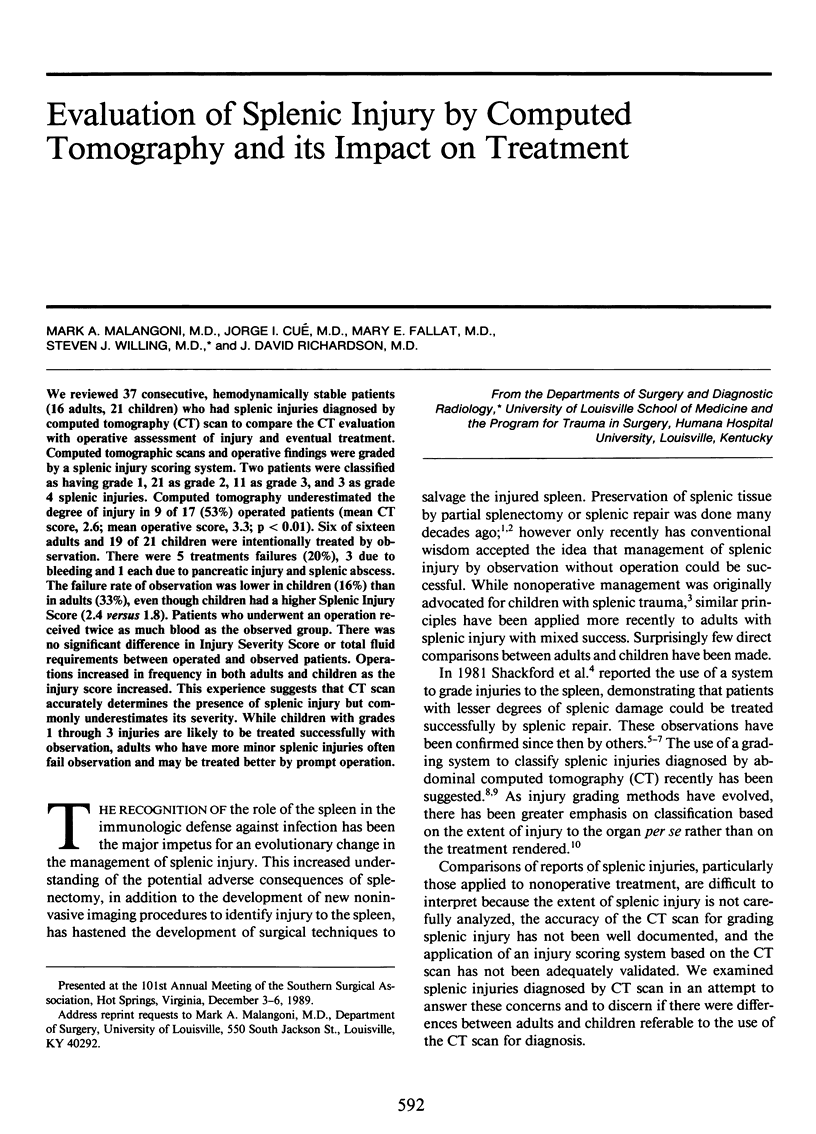
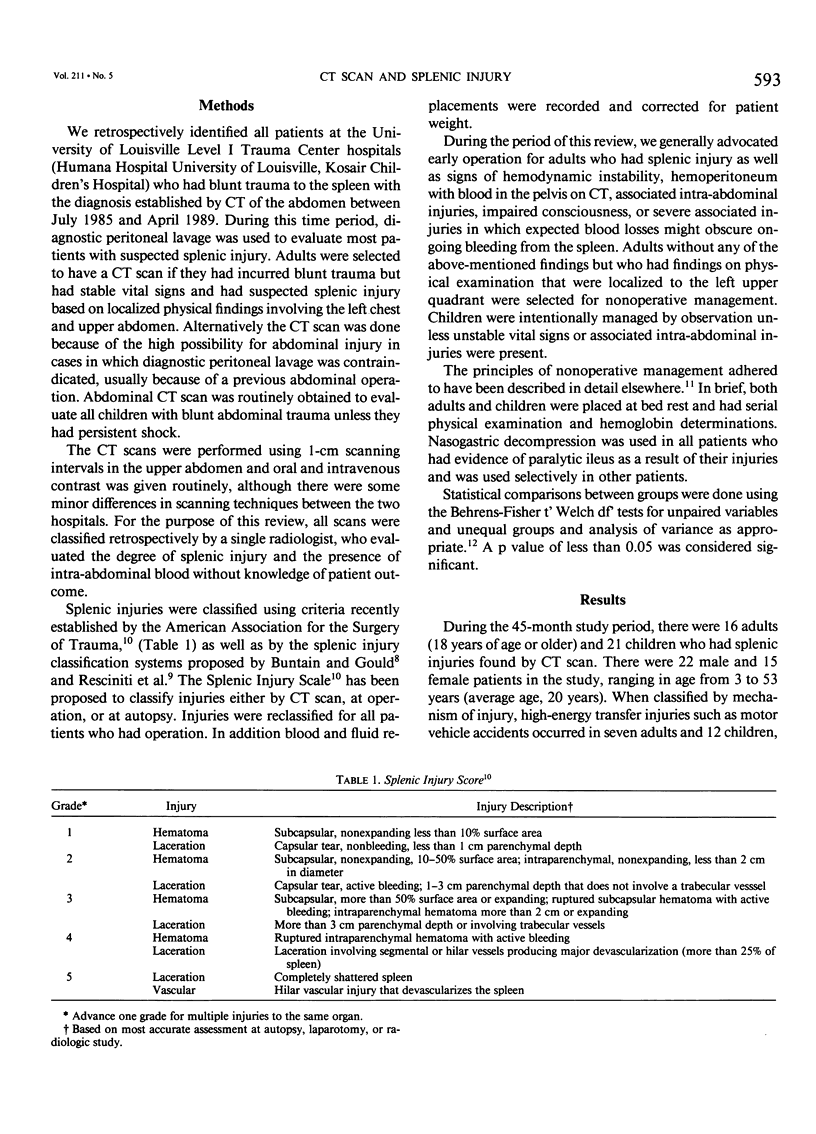
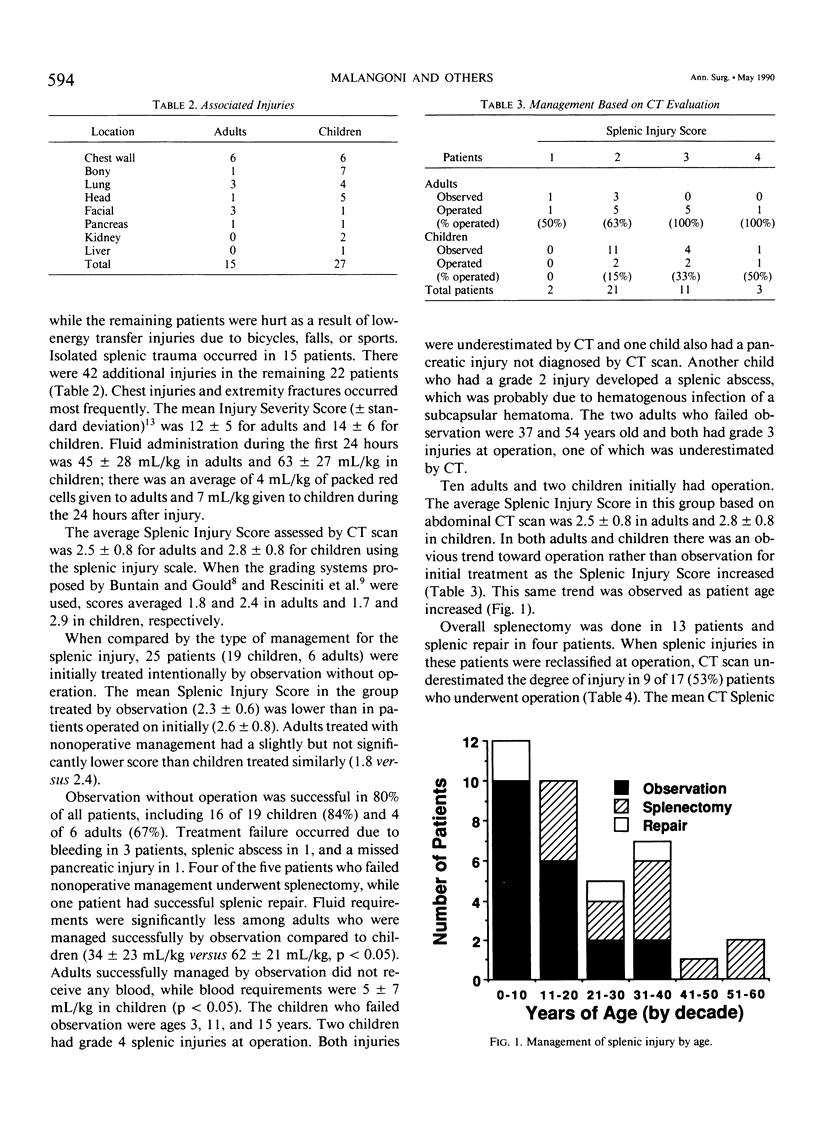
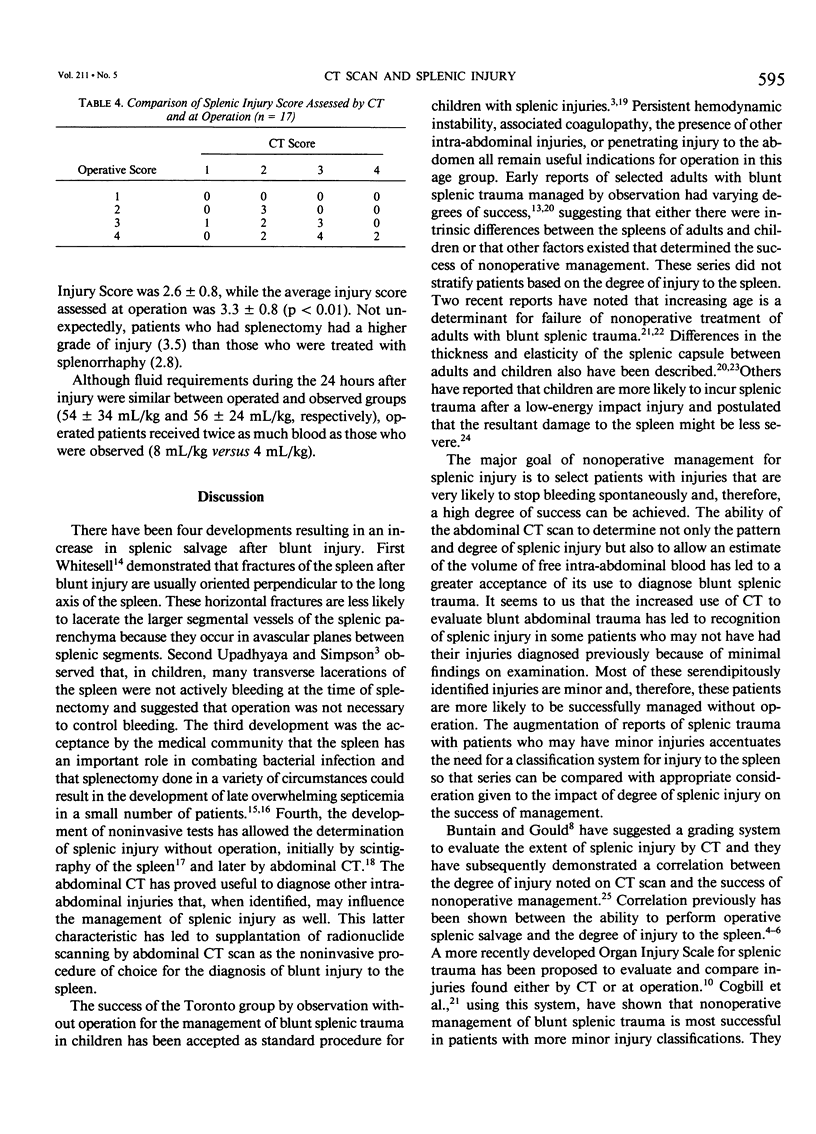
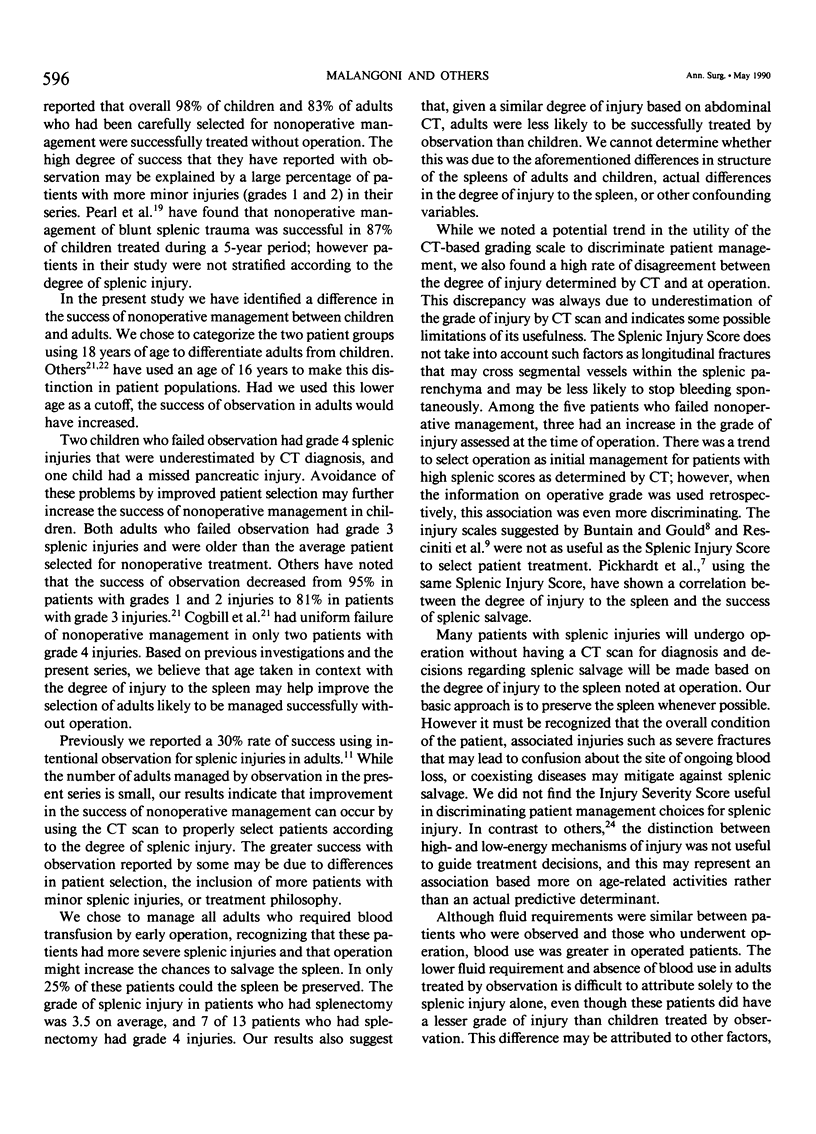
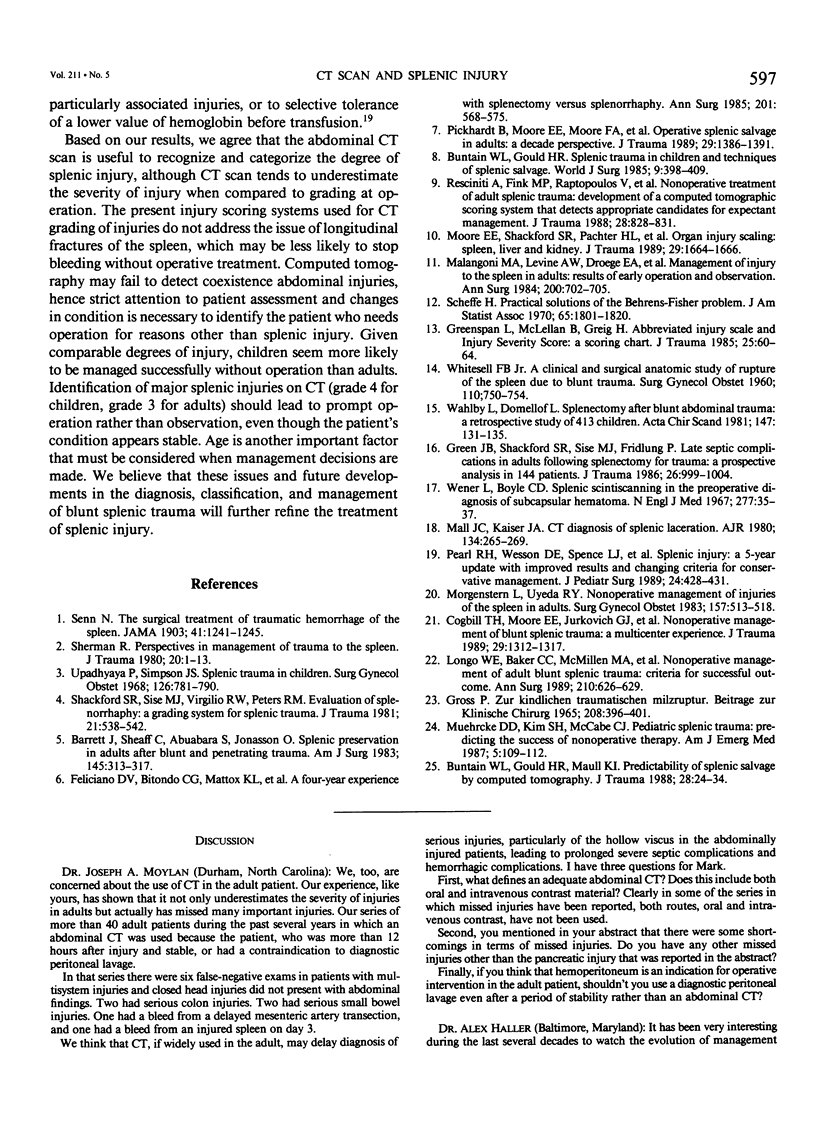
Selected References
These references are in PubMed. This may not be the complete list of references from this article.
- Barrett J., Sheaff C., Abuabara S., Jonasson O. Splenic preservation in adults after blunt and penetrating trauma. Am J Surg. 1983 Mar;145(3):313–317. doi: 10.1016/0002-9610(83)90189-7. [DOI] [PubMed] [Google Scholar]
- Buntain W. L., Gould H. R., Maull K. I. Predictability of splenic salvage by computed tomography. J Trauma. 1988 Jan;28(1):24–34. doi: 10.1097/00005373-198801000-00004. [DOI] [PubMed] [Google Scholar]
- Buntain W. L., Gould H. R. Splenic trauma in children and techniques of splenic salvage. World J Surg. 1985 Jun;9(3):398–409. doi: 10.1007/BF01655274. [DOI] [PubMed] [Google Scholar]
- Cogbill T. H., Moore E. E., Jurkovich G. J., Morris J. A., Mucha P., Jr, Shackford S. R., Stolee R. T., Moore F. A., Pilcher S., LoCicero R. Nonoperative management of blunt splenic trauma: a multicenter experience. J Trauma. 1989 Oct;29(10):1312–1317. doi: 10.1097/00005373-198910000-00002. [DOI] [PubMed] [Google Scholar]
- Feliciano D. V., Bitondo C. G., Mattox K. L., Rumisek J. D., Burch J. M., Jordan G. L., Jr A four-year experience with splenectomy versus splenorrhaphy. Ann Surg. 1985 May;201(5):568–575. doi: 10.1097/00000658-198505000-00005. [DOI] [PMC free article] [PubMed] [Google Scholar]
- Green J. B., Shackford S. R., Sise M. J., Fridlund P. Late septic complications in adults following splenectomy for trauma: a prospective analysis in 144 patients. J Trauma. 1986 Nov;26(11):999–1004. doi: 10.1097/00005373-198611000-00007. [DOI] [PubMed] [Google Scholar]
- Greenspan L., McLellan B. A., Greig H. Abbreviated Injury Scale and Injury Severity Score: a scoring chart. J Trauma. 1985 Jan;25(1):60–64. doi: 10.1097/00005373-198501000-00010. [DOI] [PubMed] [Google Scholar]
- Longo W. E., Baker C. C., McMillen M. A., Modlin I. M., Degutis L. C., Zucker K. A. Nonoperative management of adult blunt splenic trauma. Criteria for successful outcome. Ann Surg. 1989 Nov;210(5):626–629. doi: 10.1097/00000658-198911000-00010. [DOI] [PMC free article] [PubMed] [Google Scholar]
- Malangoni M. A., Levine A. W., Droege E. A., Aprahamian C., Condon R. E. Management of injury to the spleen in adults. Results of early operation and observation. Ann Surg. 1984 Dec;200(6):702–705. doi: 10.1097/00000658-198412000-00005. [DOI] [PMC free article] [PubMed] [Google Scholar]
- Mall J. C., Kaiser J. A. CT diagnosis of splenic laceration. AJR Am J Roentgenol. 1980 Feb;134(2):265–269. doi: 10.2214/ajr.134.2.265. [DOI] [PubMed] [Google Scholar]
- Moore E. E., Shackford S. R., Pachter H. L., McAninch J. W., Browner B. D., Champion H. R., Flint L. M., Gennarelli T. A., Malangoni M. A., Ramenofsky M. L. Organ injury scaling: spleen, liver, and kidney. J Trauma. 1989 Dec;29(12):1664–1666. [PubMed] [Google Scholar]
- Morgenstern L., Uyeda R. Y. Nonoperative management of injuries of the spleen in adults. Surg Gynecol Obstet. 1983 Dec;157(6):513–518. [PubMed] [Google Scholar]
- Muehrcke D. D., Kim S. H., McCabe C. J. Pediatric splenic trauma: predicting the success of nonoperative therapy. Am J Emerg Med. 1987 Mar;5(2):109–112. doi: 10.1016/0735-6757(87)90085-4. [DOI] [PubMed] [Google Scholar]
- Pearl R. H., Wesson D. E., Spence L. J., Filler R. M., Ein S. H., Shandling B., Superina R. A. Splenic injury: a 5-year update with improved results and changing criteria for conservative management. J Pediatr Surg. 1989 May;24(5):428–431. doi: 10.1016/s0022-3468(89)80394-x. [DOI] [PubMed] [Google Scholar]
- Pickhardt B., Moore E. E., Moore F. A., McCroskey B. L., Moore G. E. Operative splenic salvage in adults: a decade perspective. J Trauma. 1989 Oct;29(10):1386–1391. doi: 10.1097/00005373-198910000-00017. [DOI] [PubMed] [Google Scholar]
- Resciniti A., Fink M. P., Raptopoulos V., Davidoff A., Silva W. E. Nonoperative treatment of adult splenic trauma: development of a computed tomographic scoring system that detects appropriate candidates for expectant management. J Trauma. 1988 Jun;28(6):828–831. [PubMed] [Google Scholar]
- Shackford S. R., Sise M. J., Virgilio R. W., Peters R. M. Evaluation of splenorrhaphy: a grading system for splenic trauma. J Trauma. 1981 Jul;21(7):538–542. [PubMed] [Google Scholar]
- Sherman R. Perspectives in management of trauma to the spleen: 1979 presidential address, American Association for the Surgery of Trauma. J Trauma. 1980 Jan;20(1):1–13. [PubMed] [Google Scholar]
- Upadhyaya P., Simpson J. S. Splenic trauma in children. Surg Gynecol Obstet. 1968 Apr;126(4):781–790. [PubMed] [Google Scholar]
- WHITESELL F. B., Jr A clinical and surgical anatomic study of rupture of the spleen due to blunt trauma. Surg Gynecol Obstet. 1960 Jun;110:750–754. [PubMed] [Google Scholar]
- Wener L., Boyle C. D. Splenic scintiscanning in the preoperative diagnosis of subcapsular hematoma. N Engl J Med. 1967 Jul 6;277(1):35–37. doi: 10.1056/NEJM196707062770109. [DOI] [PubMed] [Google Scholar]
- Wählby L., Domellöf L. Splenectomy after blunt abdominal trauma. A retrospective study of 413 children. Acta Chir Scand. 1981;147(2):131–135. [PubMed] [Google Scholar]


